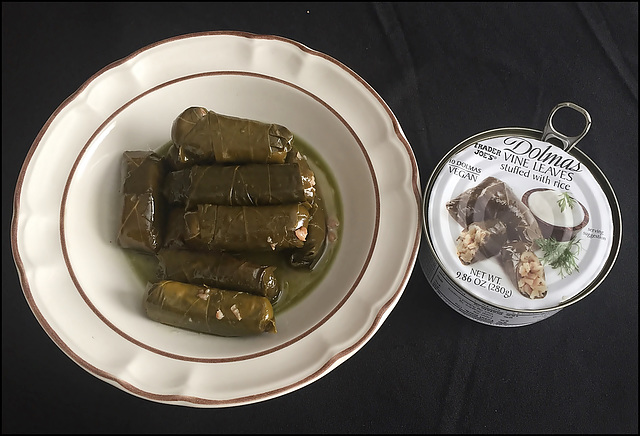Tulips
Rose
Yellow Rose
Onions and somethings...
Relaxing in Kentucky
Northern Michigan
By the Lake shore
In memory if deforestation
Before they woke up
The flow after Niagara fall
Early Spring
In lockdown
Sycamore
Bird migration
Kindly
Bilboa Park
Dreaming of paradise
Meaning
An evening in Hawaii
Phalguni or Kulur River
A message for Earth day
Bridge
Rose
Crossing
Fall Leaves
Written in Stone
Sensation
Bread / Brot
Knowledge
Sartre
House
See also...
Keywords
Authorizations, license
-
Visible by: Everyone -
Attribution + non Commercial
- Photo replaced on 26 Apr 2020
-
74 visits
Dolma / Grape Leaves / yaprak sarma


- Keyboard shortcuts:
Jump to top
RSS feed- Latest comments - Subscribe to the comment feeds of this photo
- ipernity © 2007-2024
- Help & Contact
|
Club news
|
About ipernity
|
History |
ipernity Club & Prices |
Guide of good conduct
Donate | Group guidelines | Privacy policy | Terms of use | Statutes | In memoria -
Facebook
Twitter

Stuffed vegetables are also common in Greek cuisine, called gemista or tsounidis, as well as in Italian cuisine, where they are named ripieni ("stuffed").,[6] dorma in India[7] and mahshi in Arabic
Dolma have been a part of Middle Eastern cuisine for centuries.[9] Though the word dolma itself most likely has its roots in the cuisine of the Ottoman Topkapı Palace, stuffed vegetables are attested to in pre-Ottoman Arabic cookbooks that include recipes like eggplants stuffed with meat. Likewise, in Ancient Greece, fig leaf stuffed with sweetened cheese was called thrion.[8]
The Iranian variety has been traced to at least the 17th century and in the 19th century Naser al-Din Shah Qajar's chef records several varieties including stuffed grape leaves, cabbage leaves, cucumbers, eggplants, apples, and quinces. The recorded stuffings included ground meat, sauteed mint, rice and saffron.[10]
Dolma is a common dish in Iraqi cuisine, which includes a version of stuffed cabbage leaves, onions in aubergines cooked in tomato sauce.[11] Syrians, Lebanese, Palestinians, Iraqis and Iranians have been making stuffed grape leaves for centuries. Over time, regional variations developed. In the Persian Gulf, basmati rice is preferred, and the flavor of the stuffing may be enhanced using tomatoes, onions and cumin.[9] Muslim families often serve dolma as part of the iftar meal during Ramadan and during the Eid al-Fitr celebrations that mark the end of the holy month. Assyrians prepare meatless dolmas for Lent. Large pots of dolma are prepared during the Norouz festival.[12]
Stuffed green pepper and zucchini
Dolma are part of cuisine of the Sephardic Jews as well.[13] There are some variations in Jewish family dishes that are not found in other versions. Iraqi Jewish families had a version of dolma with sweet and sour flavors that were not found in other versions.[14] During winter months cabbage was a staple food for peasants in Persia and the Ottoman Empire, and it spread to the Balkans as well. Jews in the Ottoman Empire used locally grown grape leaves and adopted the Turkish names of the dish. Jews in Eastern Europe prepared variations of stuffed cabbage rolls with kosher meat—this dish is called golubtsy in Russian, holubtsi in Ukrainian, gołąbki in Polish and holishkes or teibel in Yiddish. As meat was expensive, rice was sometimes mixed in with the meat. Jews in Europe would sometimes substitute barley, bread or kasha for the rice.[15]
Dolma in India is limited within Bengali Cuisine. The Bengali dish potoler dorma or stuffed pointed gourd is the most common example of all ~ Source Wikipedia
Sign-in to write a comment.